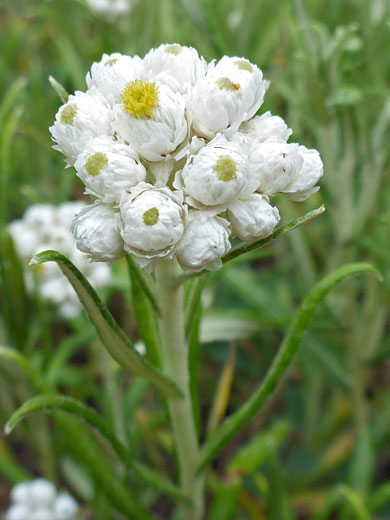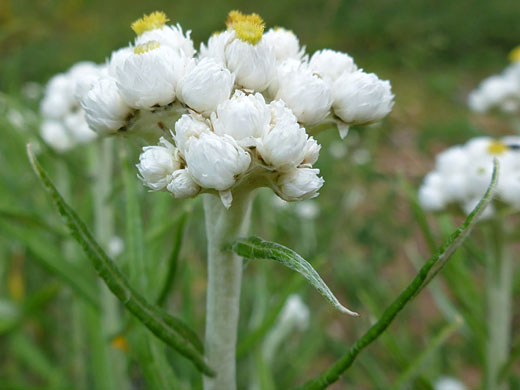Anaphalis Margaritacea, Western Pearly Everlasting
Plants > Wildflowers > Asteraceae > Anaphalis Margaritacea

Many small flowers of anaphalis margaritacea (western pearly everlasting), Yellowstone National Park
Common name:
Western pearly everlasting
Family:
Scientific name:
Anaphalis margaritacea
Main flower color:
Range:
Some areas of all the Western states between the Rocky Mountains and the Pacific Ocean
Height:
Up to 3 feet
Habitat:
Fields, hillsides, roadsides, forest clearings, high mountain slopes, from sea level to 10,500 feet
Leaves:
Lanceolate or linear, narrow, alternate, up to 5 inches long; hairy underneath
Season:
June to September
The white, petal-like rays surrounding the flowers of anaphalis margaritacea are actually thin bracts (modified leaves), at the center of which is a small group of yellow-brown disc florets, which develop slightly protruding stamens as they mature. Flowers form small but dense clusters, linked by greenish-whitish stalks, branching from the thick, rigid stem, which bears leaves all the way along though those towards the base tend to wither during flowering.
The narrow leaves have a prominent center vein, and (usually) two fainter side veins, and are covered by woolly hairs underneath; the upper surfaces are smoother but may also have some hair. Leaves are edible. Leaf edges are revolute, curled downwards.
The narrow leaves have a prominent center vein, and (usually) two fainter side veins, and are covered by woolly hairs underneath; the upper surfaces are smoother but may also have some hair. Leaves are edible. Leaf edges are revolute, curled downwards.
All Contents © Copyright The American Southwest | Comments and Questions | Contribute | Site Map









